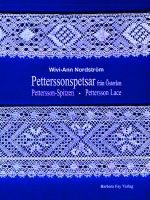Pettersson Lace by Wivi-Ann Nordstrom
A retired army doctor introduced the method of working lace on a “standard pricking” (more of that later) into the Swedish town of Delsbo in the middle of the 18th century.
Matt Pettersson was a Swedish soldier whose wife, two daughters and probably his stepson, all made lace on by this method during the early 1800’s. Wivi-Ann Nordstrom has been studying collections of Pettersson lace in various museums and reconstructing the lace and this is the first time these patterns have been made generally available.
This is a hard-covered book of 142 pages, with beautifully clear photos and working diagrams. The lace patterns are Torchon in style and there are beautifully clear photos of the finished lace, and working diagrams. The use of several languages in the book (including English) does mean that the information is confined to small paragraphs. However, I feel all necessary information is contained in these paragraphs.
Now…you all want to know about the “standard pricking”. There are two lengths of pricking in the book – one corresponds to 2mm graph paper for Bockens linen thread 50/2 or 60/2 and the other 1.6mm grid for Bockens linen thread 80/2 to 120/2.
All holes on the pricking are pricked through and it is these blank prickings which are used to work all patterns. No markings are put on the pricking at all. Every pattern has a working diagram, and the work progresses by counting out the pinholes as you work. This system works because of the geometric nature of the designs. Ground pinholes are worked without a pin. So the same pricking is used over and over again, no matter which pattern you’re working. The patterns in the book range from quite narrow edgings to the lovely wide designs used for traditional costumes and bonnets.
There are over 50 patterns in the book, as well as pages of motifs which can be used by the lacemaker to design her own patterns.
I love the glimpse of history in this book – and the designs have that lovely “clean” look I often associate with Swedish and other Continental designs. Published and supplied by Barbara Fay, it cost me $64 to get a single copy here…if you have friends who want to order, you could share the cost of the postage between you to save a couple of dollars. However, I think it’s good value for money, even though I paid the full postage myself.
